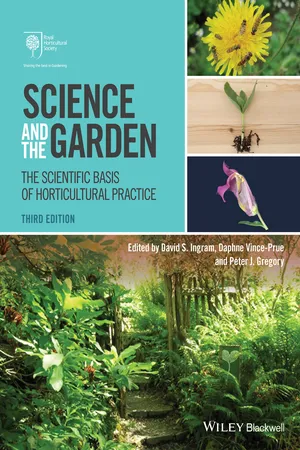
Science and the Garden
The Scientific Basis of Horticultural Practice
- English
- ePUB (mobile friendly)
- Available on iOS & Android
Science and the Garden
The Scientific Basis of Horticultural Practice
About this book
Most conventional gardening books concentrate on how and when to carry out horticultural tasks such as pruning, seed sowing and taking cuttings. Science and the Garden, Third Edition is unique in explaining in straightforward terms some of the science that underlies these practices. It is principally a book of 'Why' – Why are plants green? Why do some plants only flower in the autumn? Why do lateral buds begin to grow when the terminal bud is removed by pruning? Why are some plants successful as weeds? Why does climate variability and change mean change for gardeners? But it also goes on to deal with the 'How', providing rationale behind the practical advice.
The coverage is wide-ranging and comprehensive and includes: the diversity, structure, functioning and reproduction of garden plants; nomenclature and classification; genetics and plant breeding; soil properties and soil management; environmental factors affecting growth and development; methods of propagation; size and form; colour, scent and sound; climate; environmental change; protected cultivation; pest, disease and weed diversity and control; post-harvest management and storage; garden ecology and conservation; sustainable horticulture; gardens and human health and wellbeing; and gardens for science.
This expanded and fully updated Third Edition of Science and the Garden includes two completely new chapters on important topics:
- Climate and Other Environmental Changes
- Health, Wellbeing and Socio-cultural Benefits
Many of the other chapters have been completely re-written or extensively revised and expanded, often with new authors and/or illustrators, and the remainder have all been carefully updated and re-edited. Published in collaboration with the Royal Horticultural Society, reproduced in full colour throughout, carefully edited and beautifully produced, this new edition remains a key text for students of horticulture and will also appeal to amateur and professional gardeners wishing to know more about the fascinating science behind the plants and practices that are the everyday currency of gardening.
Frequently asked questions
- Essential is ideal for learners and professionals who enjoy exploring a wide range of subjects. Access the Essential Library with 800,000+ trusted titles and best-sellers across business, personal growth, and the humanities. Includes unlimited reading time and Standard Read Aloud voice.
- Complete: Perfect for advanced learners and researchers needing full, unrestricted access. Unlock 1.4M+ books across hundreds of subjects, including academic and specialized titles. The Complete Plan also includes advanced features like Premium Read Aloud and Research Assistant.
Please note we cannot support devices running on iOS 13 and Android 7 or earlier. Learn more about using the app.
Information
CHAPTER 1
Diversity in the plant world
Summary
Introduction


Creating order out of disorder

Table of contents
- Cover
- Royal Horticultural Society
- Title page
- Copyright
- Preface to third edition
- Preface to second edition
- Preface to first edition
- Chapter 1 Diversity in the plant world
- Chapter 2 The plant body: structure and function
- Chapter 3 Reproduction: securing the future
- Chapter 4 Naming plants
- Chapter 5 Selecting and breeding plants
- Chapter 6 Soils and roots
- Chapter 7 Soil cultivation and fertility
- Chapter 8 The plant environment: light and water
- Chapter 9 Plants and the seasons
- Chapter 10 Growing plants from seed
- Chapter 11 Vegetative propagation
- Chapter 12 Size and form
- Chapter 13 Colour, scent and sound in the garden
- Chapter 14 Climate and weather
- Chapter 15 Climate and other environmental changes
- Chapter 16 Protected cultivation
- Chapter 17 The diversity of the undesirables
- Chapter 18 Controlling the undesirables
- Chapter 19 Maturation, ripening and storage
- Chapter 20 Garden ecology
- Chapter 21 Garden wildlife and conservation
- Chapter 22 Low-input and low-impact gardening
- Chapter 23 Health, well-being and socio-cultural benefits
- Chapter 24 Gardens for science
- Glossary
- Index
- EULA